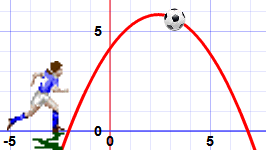Quadratic Equations
& Expressions
Watch and complete your notes on the videos below.
Afterwards, read about the Quadratic Equation. Then, test your knowledge!
Quadratic Equations
An example of a Quadratic Equation:
Quadratic Equations make nice curves, like this one:


Name
The name Quadratic comes from "quad" meaning square, because the variable gets squared (like ).
It is also called an "Equation of Degree 2" (because of the "2" on the x)
Standard Form
The Standard Form of a Quadratic Equation looks like this:
-
a, b and c are known values. a can't be 0.
-
"x" is the variable or unknown (we don't know it yet).
Here are some examples:


Hidden Quadratic Equations
As we saw before, the Standard Form of a Quadratic Equation is
But sometimes a quadratic equation doesn't look like that!
For example:


How Do You Solve Them?
The "solutions" to the Quadratic Equation are where it is equal to zero.
They are also called "roots", or sometimes "zeros"

There are usually 2 solutions (as shown in this graph). And there are a few different ways to find the solutions:
-
We can Factor the Quadratic (find what to multiply to make the Quadratic Equation)
-
Or we can Complete the Square
-
Or we can use the special Quadratic Formula:
Just plug in the values of a, b and c, and do the calculations.
We will look at this method in more detail now.
About the Quadratic Formula
Plus/Minus
First of all what is that plus/minus thing that looks like ±?
Here is an example with two answers:



But sometimes we don't get two real answers. Imagine if the curve "just touches" the x-axis. Or imagine the curve is so high it doesn't even cross the x-axis! This is where the "Discriminant" helps us...
Discriminant
Do you see b2 − 4ac in the formula above? It is called the Discriminant, because it can "discriminate" between the possible types of answer:
-
when b2 − 4ac is positive, we get two Real solutions
-
when it is zero we get just ONE real solution (both answers are the same)
-
when it is negative we get a pair of Complex solutions
Complex solutions? Let's talk about them after we see how to use the formula.
Using the Quadratic Formula
Just put the values of a, b and c into the Quadratic Formula, and do the calculations.



Remembering The Formula
A kind reader suggested singing it to "Pop Goes the Weasel":

Try singing it a few times and it will get stuck in your head!
Or you can remember this story:



